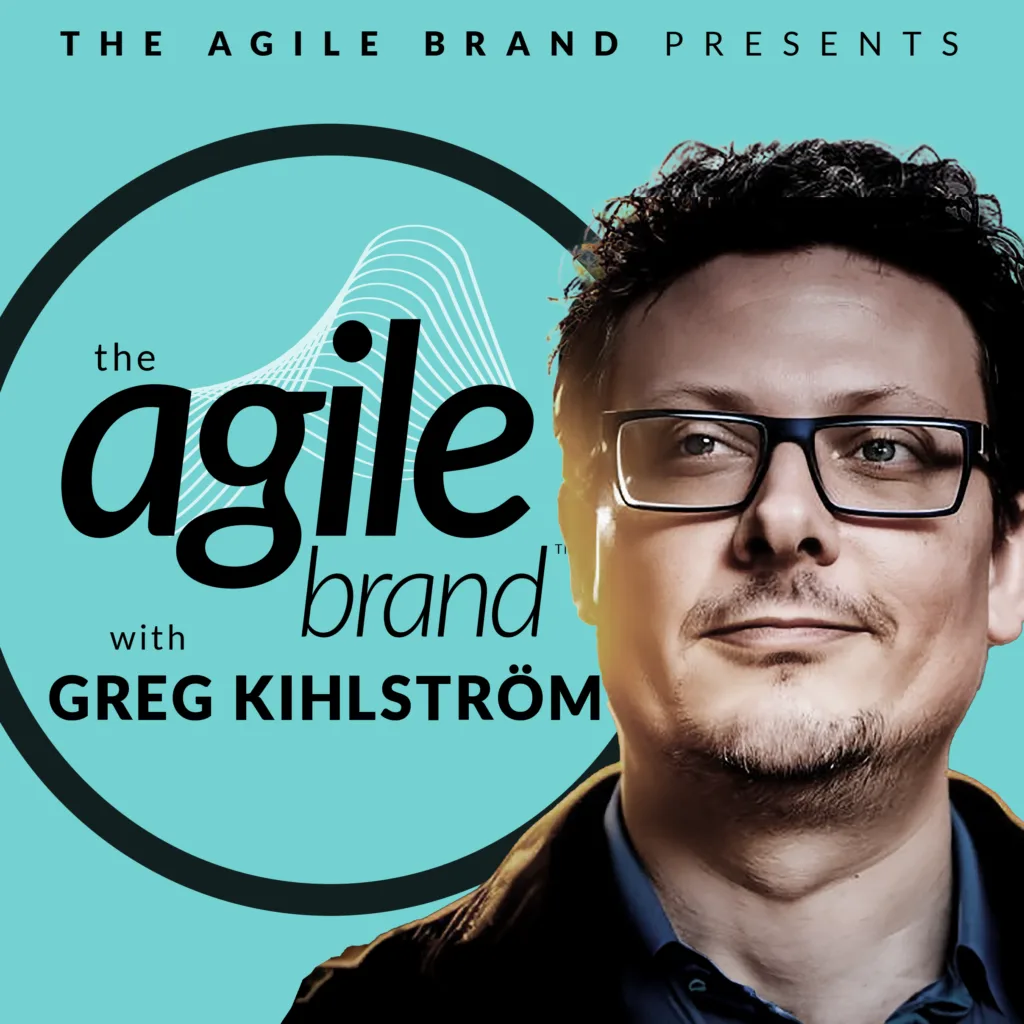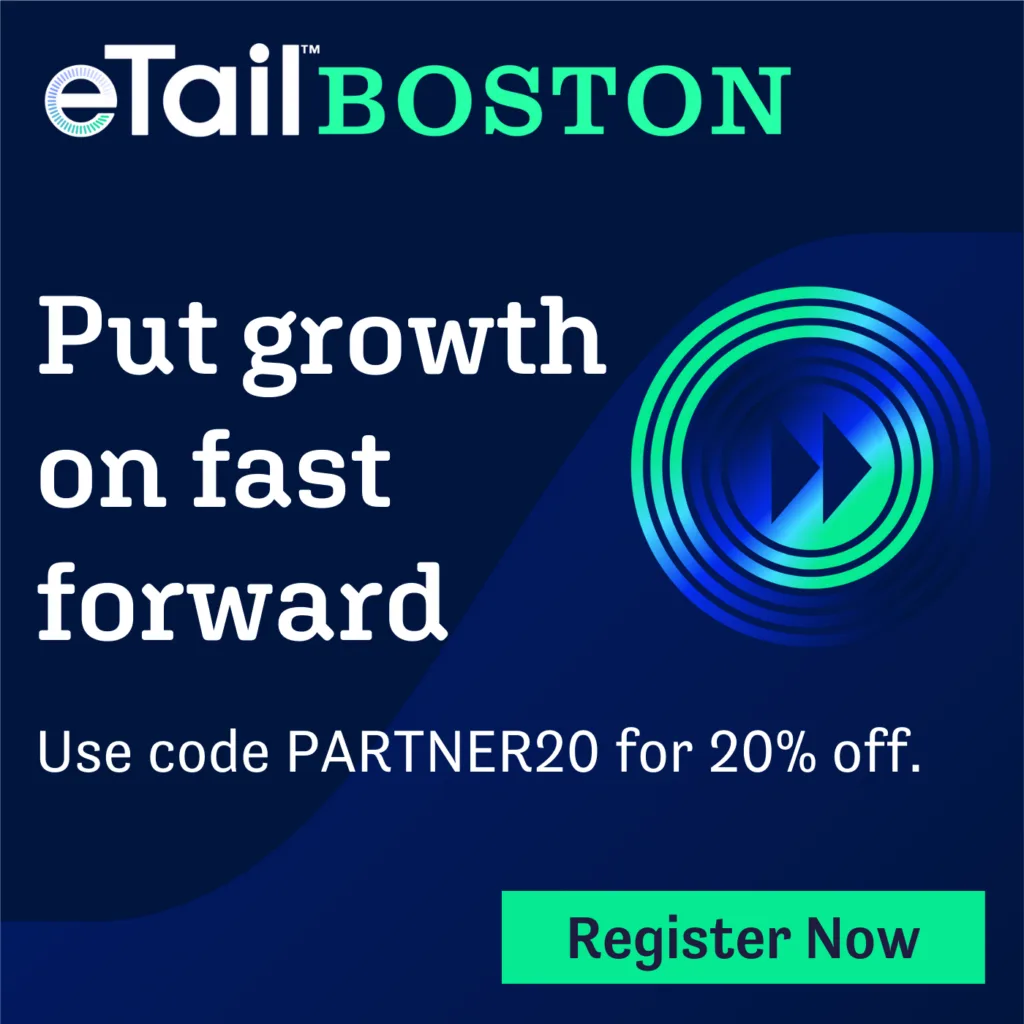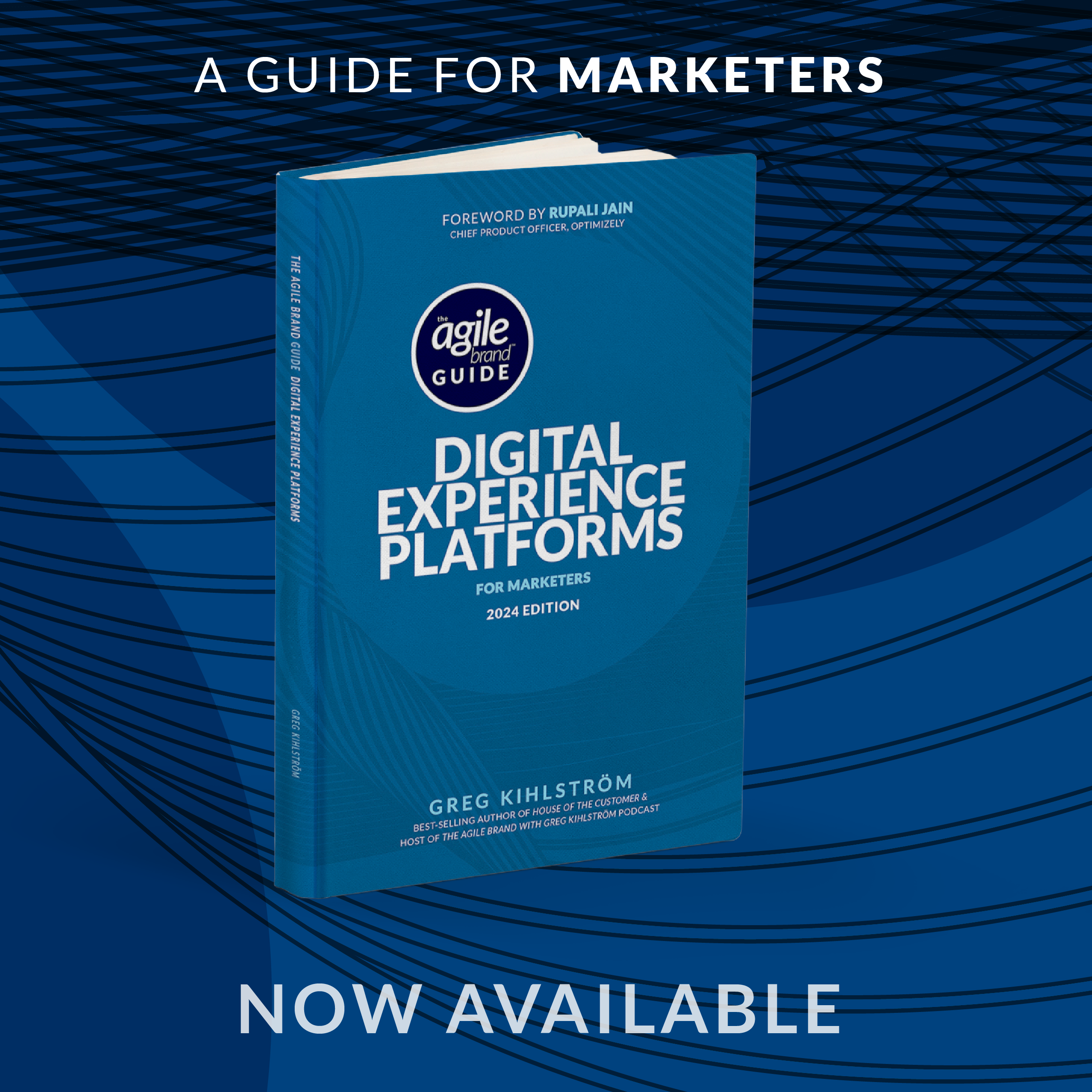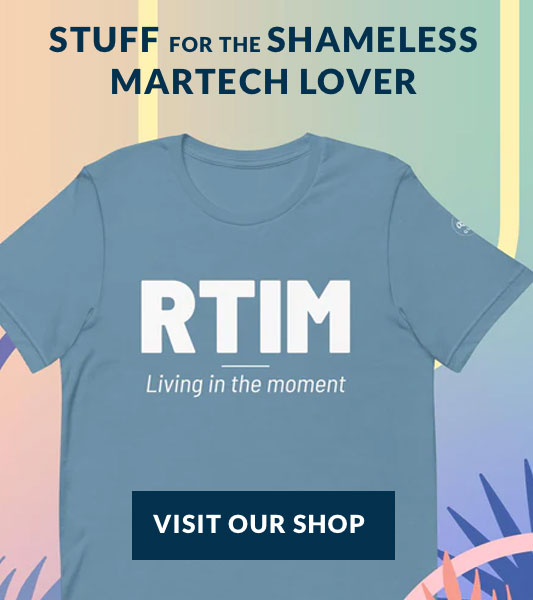What if your most loyal customers are the ones you helped spend less?
Agility in marketing isn’t just about moving faster — it’s about aligning brand intentions with customer outcomes in real-time, even when that means giving up short-term gains to earn long-term trust.
Today we are here at PegaWorld 2025 at the MGM Grand in Las Vegas, and we’re going to talk about how Telenet is transforming customer loyalty in a saturated market — not with discounts or gimmicks, but with ethical, AI-driven decisions that prioritize long-term value.
To help me discuss this topic, I’d like to welcome Tine Van Calster, Product Owner Segment of One at Telenet.
Resources
Telenet: https://www.telenet.be
The Agile Brand podcast is brought to you by TEKsystems. Learn more here: https://www.teksystems.com/versionnextnow
Catch the future of e-commerce at eTail Boston, August 11-14, 2025. Register now: https://bit.ly/etailboston and use code PARTNER20 for 20% off for retailers and brands
Online Scrum Master Summit is happening June 17-19. This 3-day virtual event is open for registration. Visit http://www.osms25.com and get a 25% discount off Premium All-Access Passes with the code osms25agilebrand
Don’t Miss MAICON 2025, October 14-16 in Cleveland – the event bringing together the brights minds and leading voices in AI. Use Code AGILE150 for $150 off registration. Go here to register: https://bit.ly/agile150
Connect with Greg on LinkedIn: https://www.linkedin.com/in/gregkihlstrom
Don’t miss a thing: get the latest episodes, sign up for our newsletter and more: https://www.theagilebrand.show
Check out The Agile Brand Guide website with articles, insights, and Martechipedia, the wiki for marketing technology: https://www.agilebrandguide.com
The Agile Brand is produced by Missing Link—a Latina-owned strategy-driven, creatively fueled production co-op. From ideation to creation, they craft human connections through intelligent, engaging and informative content. https://www.missinglink.company
Transcript
Greg Kihlstrom (00:00)
What if your most loyal customers are the ones you helped spend less? Agility and marketing isn’t just about moving faster, it’s about aligning brand intentions with customer outcomes in real time, even when that means giving up short-term gains to earn long-term trust. Today we are here at PegaWorld 2025 at the MGM Grand in Las Vegas, and we’re going to talk about how Telenet is transforming customer loyalty in a saturated market.
not with discounts or gimmicks, but with ethical AI-driven decisions that prioritize long-term value. To help me discuss this topic, I’d like to welcome Tine Van Calster, Product Owner, Segment of One at Telenet. Tine, welcome to the show.
Tine Van Calster (00:38)
Hello, thank you. I’m happy to be here.
Greg Kihlstrom (00:40)
Yeah, looking forward to talking about this with you and great to be here in person with you at the show. Before we dive in, why don’t we get started with you giving a little background on yourself and what you’re currently doing at Telenet.
Tine Van Calster (00:51)
So I’m currently a product owner at Telenet, what’s in a name. But my background is actually in AI. So before I started working at Telenet about six years ago, I did a PhD in AI and then went through data science to product ownership of segment of one, which is what I’m currently doing. And that’s basically the name for our program that has to do with data-driven hyper-personalized marketing. And it’s all built on Pegacdh.
So I lead the team that builds and configures the marketing campaigns in the tool and works closely together with all of our marketing teams and with our technology teams to really bring it to life for our customers. So that’s basically what we’re doing.
Greg Kihlstrom (01:28)
Love it, love it. Yeah, so let’s dive in and we’ll talk a bit about how you’re using Pega Customer Decision Hub in a minute. I want to kind of start at a high level here, talk about the strategy and can you give us an overview of the Check and Smile initiative? What inspired Telenet to take such a customer first and some might say counterintuitive approach in a highly competitive market?
Tine Van Calster (01:53)
Sure, so maybe let’s start with explaining what Check and Smile is all about. So Check and Smile is an application in our app. So it’s only inbound and it’s only for our existing customers. And the whole idea is that we do proactive checks for our customers that make them happy. So hence the name Check and Smile. And we do it for four different facets of their experience of their products together with us. And the two main ones are their network.
So we do a check on their network quality and also offer them proactive solutions if something is going wrong. So that might be sending a technician or sending a new modem or whatever is needed. And secondly, their products, which is more of the ethical side. So we know that some of our customers are maybe having some additional services that they’re paying for, but not using. So that’s where we try to make a difference with either trying to stimulate the usage to make sure that they get the maximum value for money out of their current product or actually suggesting a downgrade or even suggesting to turn off a certain service if they’re really not a good fit for the customer. So the idea of Check and Smile is to start from our customers, start from their needs, think about the long term. So think about just building a good customer relationship, whatever that means, not only focusing on the short term and providing that as a service in our app with an effortless digital journey behind it so that it’s easy for them to do whatever we are suggesting them to do. So that’s basically the idea behind Chicken Smile.
Greg Kihlstrom (03:17)
Yeah, I mean, it sounds like that customer relationship is a key part of that. you know, from a product ownership standpoint, you know, how do you define, typically speaking, you know, success would be like greater revenue or, you know, things like that. You know, how do you define success or something like check and smile when the immediate financial return might not look great on paper?
Tine Van Calster (03:39)
So it didn’t look great on paper, no, but that was a very conscious move. So it’s actually, it was a reaction to customer service, had some hiccups. We saw it in our brand perception. And so that’s also the KPIs that we are focusing on how loyal our customers, how are they perceiving our brands? So we’re looking at things like NPS, but also in our brand tracker, we have certain questions like, do you feel valued as our customer and so on?
We’re more tracking it from a customer loyalty or customer perception point of view. And then next to that also, are they really engaging with the check and smile? So what is the acceptance rate whenever we offer something? Are they actually likely to do it, whatever we are telling them? And then finally, an operational impact. So we did want to make sure that it didn’t put too much extra stress on our contact centers or on our technicians to make sure that they could handle whatever we are trying to provide to our customers. And that’s also the reason why we started with only inbounds, so only in the app. And then now the next round will also be proactive outbounds, actually sending customers emails whenever there’s something ready for them in the app. And there also customer engagement with that communication will be the first KPI that we are going to track.
Greg Kihlstrom (04:52)
Yes, I mean, it definitely it sounds like it’s about the long term value, right? Yeah. Yeah. Yeah. And we’ll we’ll get to that in a minute as well. But yeah, I wanted to also talk about the technology behind it. So, you know, we’re here at Pega World here. Let’s let’s talk a little bit about, you know, how you’re leveraging Pegas, in this case, customer decision hub to power those, you know, those offers are next best actions. Right. So, you know, what’s what’s different about this approach compared to maybe more traditional personalization or targeting methods.
Tine Van Calster (05:22)
Well, we’ve been doing Segment of One for a little while already. So it’s about five years ago that the program started. So we’ve come a long way and it was always PegaCDH as a tool that was behind it. But we’ve been through a path of five years of capability building, of really connecting it to all of our channels and then the change management that has to come in it. So by the time that Check and Smile came around as a new CVP, we were kind of already established as a team, as a tool.
And it was a logical fit with Check and Smile because it’s always on, it’s hyper-personalized. And it is omni-channel. So the main difference for me when we launched segment of one was two things. First of all, being extremely data-driven and AI-driven in every decision. And second of all, being omni-channel. So not only doing push marketing and being the annoying next email in an inbox, but also being there for our customers when they are reaching out to us. So making sure that our advisors are empowered with the next best actions, making sure that our website or app, everything is there. Because there we see the real interaction and the real uplift of the capabilities of CDH. And then Outbound is more like an additional bonus on top instead of being the main star, let’s say, which is usually the case in a traditional approach.
Greg Kihlstrom (06:38)
Yeah, I mean, think that hyper-personalized and omnichannel, mean, lots of people are talking about that, but I think in reality, there’s this, a lot of personalization is literally like substitute first name, last name or something. So it’s either what I would call substitution, not really personalization, or it can feel impersonal even though it’s personalized, it seems kind of intuitive, but.
How do you balance hyper automation with the human elements of things like trust and empathy so that it feels real and feels personalized to the individual?
Tine Van Calster (07:17)
That’s a very good question. And to be honest, we’re still in a learning curve there. So it’s not easy to really make it feel super personal to your brands at scale. So we were lucky that Check & Smile wasn’t too big to start with. It was a manageable amount of next best actions where we could really do iterations with our brand managers and with the copywriters to make sure that it felt like the TailorNet logo is a little winky face. I don’t know if you know it.
And so we always say the TailorNet wing has to be in there because otherwise it’s not the TailorNet product or CVP that we are offering. And that is definitely in there. But to do that at scale is not easy. And even then we got the feedback from some of our customers that they don’t fully trust it yet. Because we are actively promoting downgrades and movements that they wouldn’t expect from their telco provider. We see that we need to be even more transparent on what is behind that decision.
It might be a complicated AI model that is behind it, but you need to be able to explain it to your customer. Why is this for you the next best action? And it’s also a capability that we’re now working on to provide that even more personalized data in the message to really make the link with, for example, usage or just a customer profile with what we are offering them. So that’s for us the next frontier, let’s say for check and smile.
And other than that, it’s a good collaboration still with your brand managers because in the end they put the flavor on top of it. And that will be the case even in the world of Gen.ai. There will always be a human winky face that needs to be added on top, I think.
Greg Kihlstrom (08:51)
Yeah, yeah, and I mean, does seem like though that the right choosing the right platform that has the ability to be explainable is pretty key as well as I mean, you mentioned which, you know, I’ve seen, you know, in my experience as well, starting with a campaign, you know, not starting enterprise wide, but, know, starting with things that you can then build on and optimize seems like the right approach because then you can you can expand that as much as, know, you want.
Tine Van Calster (09:18)
Yeah, which is not what we did. So, yeah, it was because we were like in an IT transformation, etc. It just happened that PegaCDH was really built out as a capability and connected to all of our channels, even before one campaign went live on it, which was a very steep learning curve for us then and for marketing to suddenly you have like these Rolls-Royce, but you don’t even have your driver’s license.
And so figuring that out was definitely, it took a while, but once we got the hang of it and we saw, these are the best practices, now we can really scale up. And that’s what my team has been doing the last three years. But yeah, it would have been smarter to start very small and then learn from that and then keep going. So that’s also what we’re now trying to do. For example, with Check and Smile, start with a very, not basic set, but at least a limited set of next best actions and just keep adding on that.
And that’s what we’re doing now this year. It’s our second run of Check and Smile. So adding in new journeys to make sure that the customer has the best experience.
Greg Kihlstrom (10:18)
So let’s go back to the topic of customer loyalty and the long-term or lifetime value. So, you know, as we were just talking earlier, you mentioned this approach has increased customer loyalty and renewals. Can you share, you know, what kind of behaviors or insights or metrics can you share around that?
Tine Van Calster (10:36)
Well, as I said before, the main KPIs that we are tracking are our brand’s KPIs. So we especially wanted to see if this is the type of service that our customers would enjoy and if there was a side effect on our app usage. Because whenever I’m at a conference like PayaWorld and I see the banking colleagues and you know that their customers come to the app every single day and then you don’t do that for a telco app because you only do that if you’re in trouble or something is not working or you’re paying too much.
And so this is actually a reason for our customers to come to our app. So one of the side effects is that we had, especially in the first weeks after launch, a lot more app downloads and a lot more new app users, which was a very nice side effect. But then for our brand KPIs, we saw that actually 50 % of our customers feel more valued because we now offer this service. And then we hope that gets even better now that we’re going to add the proactive layer on top where we reach out to them whenever something is waiting for them in the app.
We’re hoping that that will bring an additional effect. And we actually also checked with our non-customers to see if they would like this or not. And actually more than 60 % said, because this service is there, and especially with the network quality checks and so on, I would consider Tailnet as my provider if I want to switch, which is a nice effect as well. We’re not there yet because there’s still a group, as I said before, that doesn’t fully trust it yet. So that really indicates, you know, it sounds too good to be true, so what’s the catch? So we’re trying to see how to deal with that. But overall, already very promising results. Also a decent uptake of the offer, so around 10 % of the offers that we give are accepted, which is not bad if you compare it to a traditional campaign. So good first results, but still building on the CVP, so making sure that it’s better and better.
Greg Kihlstrom (12:17)
Yeah, and so I know you’ve touched a bit on this, what have you learned about customer expectations in the telecom environment? mean, you mentioned the idea that it’s often kind of a transactional, like my power went out the other day and I was on the site checking and stuff like that, but it was a very reactive thing. I don’t go there every day. So what have you learned about customer expectations, value transparency, and brand behavior?
Tine Van Calster (12:43)
Yeah, well, when we came up with the CVP, it was as a reaction to a situation where we had brand loyalty and brand perception going down. So of course, the first thing we did was go to our customers and just ask them, what do you expect from your hotel co-provider? And the answers that they gave were really, for me, astonishing. They expect you to bring these effortless journeys. It has to be proactive. It has to be completely fitting to my needs and also has that layer of empathy on top. then Check & Smile was born as a CVP to try and touch on all of those aspects. But I remember it mostly was wow, expectations are extremely high and not easy to go away from that purely transactional behavior to really building a relationship with your customer. And we see it going in the right direction, but it’s, yeah.
It’s an everyday, not battle, but everyday learning curve to see how can we manage all of those very big expectations. But it’s a nice step, I think, in the right direction. Yeah.
Greg Kihlstrom (13:43)
Yeah. So last thing I want to talk about is just, you touched on the internal change that’s required here and initiatives like you’re talking about, it requires a cultural shift and as well as a technological shift. What did it take to internally to get buy-in across stakeholders for, and to talk about the check and smile thing, might seem kind of like a risky strategy, You’re potentially giving up
revenue without a promise of return. How did you go about the internal part of making that happen?
Tine Van Calster (14:16)
Well, there’s segment of one and there’s check and smile. So for segment of one, because we’ve been doing it for five years, that’s where the real mindset shift or change management had to happen. So we were lucky enough by the time we arrived at check and smile, that the idea of hyper personalization and data-driven marketing was already kind of business as usual by then. So for segment of one, it was really a long time of…working together with marketing and seeing how can these capabilities really reinforce what you’re doing. And I think there for me, the biggest shift happens once we started to get out of the conversation. Segment of one or the always on campaigning is better than what you are doing. If you just say it’s an additional thing on top, it complements it, it can reinforce whatever you are doing, then the real team, because they saw, okay, it’s not a competition.
It’s just something additional that I can use to make me hit my targets, which is eventually what they want to do. So that’s segment one. And for check and smile, yes, it was risky, but it was really led by our head of marketing as, know, this is a necessary reaction to what is now happening in our markets with our customers, how they are perceiving us. And the original code name for the project, because we always have code names, was Braveheart.
It was really like just standing up for your principles, which is customer centricity and just going to battle in whatever way we need to get to the end result and really, you know, with brave hearts, make sure that we get there. We also had a very strict timeline. So the idea was we have to do the marketing campaign on this date. We have six months to build an app that works for our customers. And she really made sure that everyone rallied behind the idea and that all the teams freed up their time and made sure that the deadlines were kept. And we did it in six months. yeah, internal PR is not unimportant. So come up with a good code name and then everyone rallies behind you.
Greg Kihlstrom (16:13)
Well, two last questions for you here. We’re here, I know we’re relatively early on at PegaWorld here, but so far, what’s been a highlight or what are you most excited about this year at PegaWorld?
Tine Van Calster (16:26)
Well, I think as most people answer, especially given my background in AI, I’m also going to my gen.ai. Yeah. So in the last few years, we’ve had the bubble of gen.ai growing, and it’s the scalability and the democratization basically of AI. But my personal background was always more in predictive and making the combination between the two, like putting the amazing customer experience of gen.ai or user experience on top of the predictive.
which hopefully is coming together in the CDH Blueprint. I’m really looking forward to demoing for our marketing teams, like what can you do with Blueprints to, you know, ideate even more and see with that tail and that winky face on top, that layer, what can we do to make better marketing campaigns or better offers to our customers. I’m really looking forward to that.
Greg Kihlstrom (17:15)
Nice, I love that. the combination of predictive and generative is very exciting to me. I feel like it’s the thing that enables one-to-one personalization. We’ve been talking about personalization for at least a decade or more, but it enables that. definitely, mean, Blueprint, I was amazed last year at what it could do. It’s come a long way in a year as well. So yeah, definitely excited to play with it a little bit here as well.
So last question for you, I like to ask everybody on the show, what do do to stay agile in your role and how do you find a way to do it consistently?
Tine Van Calster (17:49)
Also a good question. I think what is more simple. So I’ve been leading the same team for three years and we started from a place where we were very much still fighting for a reason of existing existence. Like CDH wasn’t the norm yet when it came to marketing. And now it is. So the world has really changed. And it meant that in our team, we continuously had to recalibrate.
really have the open discussion on roles and responsibilities, how is the team working together, can we maybe work together with marketing in a different way, how do we do proper stakeholder management, so focusing on all of those different aspects regularly, so making the time with the team to have the discussion on what is going well, what isn’t going well, and not being afraid to maybe change even little things about your way of working together with others or within the team. And that really makes a difference for me. So having the open conversation specifically.











